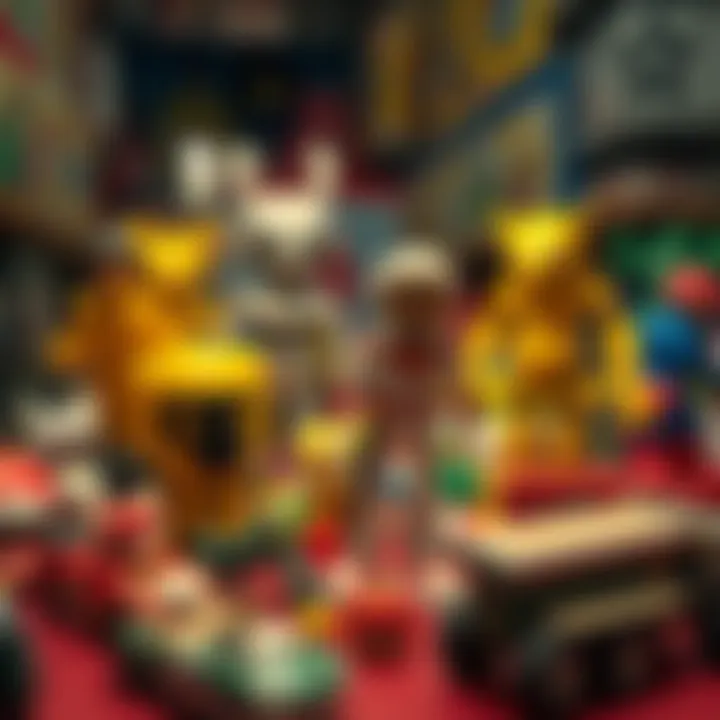The Value of Collectible Toys: A Comprehensive Guide


Intro
The world of collectible toys often conjures up images of nostalgia and childhood memories. For many, these items are not just playthings but treasured artifacts tied to moments of joy and excitement. However, for collectors and investors alike, this fascination can lead to the pursuit of toys that hold significant monetary value. Just like any other collectible, understanding the nuances of collectible toys involves peeling back several layers, from historical significance to market dynamics.
In this article, we will journey through the fascinating landscape of collectible toys. We will explore categories that have captured the hearts and wallets of collectors, discuss what makes some toys more valuable than others, and provide essential tips for evaluating and maintaining these pieces. It’s a mix of passion and investment, a blend of nostalgia and strategy that appeals to both novice and seasoned investors. Whether it’s a rare Star Wars action figure or a vintage Barbie doll, knowing what to look for could mean the difference between a delightful hobby and a lucrative enterprise.
Key Terms and Concepts
Definition of Key Terms
To delve deeper into the world of collectible toys, it’s crucial to familiarize oneself with the terminology that shapes this field. Here are a few key terms you may encounter:
- Mint Condition: A term often used to describe items that are in pristine shape, free from any damage or wear.
- Limited Edition: Toys produced in limited quantities, often leading to higher demand and value.
- Market Value: The price a toy can fetch in the current market; influenced by demand, rarity, and condition.
- Collector’s Market: The specific group of buyers and sellers focused on collectible toys.
Importance of Understanding Terminology
Understanding these terms sets the foundation for effective communication in the collectible toy community. Misinterpretations can lead to misvaluations. Imagine walking into a toy fair and referring to a condition that is actually deemed acceptable as "mint"—that could cost you more than just credibility. Having a grasp on the lingo creates opportunities to negotiate better and facilitates a deeper appreciation of the pieces at hand.
Investment Strategies
Long-term vs. Short-term Investment
When it comes to collectible toys, buyers often sit on a spectrum between wanting immediate returns and nurturing long-term investments. Long-term investors focus on toys that are predicted to appreciate over time due to their rarity and historical significance. Short-term investors, on the other hand, might chase after trending pieces, hoping for a quick flip.
- Pros of Long-term Investments:
- Pros of Short-term Investments:
- Greater chance for appreciation.
- Often less volatile.
- Collector’s intrinsic emotional value.
- Fast returns.
- Excitement of hunting for trends.
Risk Tolerance and Asset Allocation
An essential part of any investment strategy is understanding your risk tolerance. Not all collectible toys will appreciate, and the market can be as unpredictable as the weather. Knowing how much to allocate toward your toy investments can help ensure you don’t put all your eggs in one basket.
Consider diversifying your collection:
- Invest in various categories—action figures, die-cast cars, or vintage dolls.
- Look for items across different price points, ranging from high-value rare finds to affordable collectibles that you can enjoy without breaking the bank.
In summary, the realm of collectible toys is both exciting and multifaceted. Armed with the right knowledge, terms, and strategies, both novice and seasoned collectors can navigate this market effectively.
Preamble to Collectible Toys
In today’s dynamic marketplace, collectible toys have carved out a unique niche, blending nostalgia with investment potential. As interests in various types of collectibles have surged, understanding the landscape of collectible toys is essential for both seasoned collectors and newcomers. When one thinks of collectible toys, images of action figures, dolls, or limited-edition sets often come to mind. However, the relevance goes beyond just playthings—these items can hold significant monetary value, making them a serious consideration for anyone exploring investment avenues.
Definition and Significance
Collectible toys are more than mere objects; they evoke memories and cultural significance. By definition, a collectible toy is an item made for play that can be grouped into various categories, often produced in limited numbers, which increases their scarcity and desirability. These toys can be anything from vintage action figures to nostalgic board games that have stood the test of time.
The importance of understanding collectible toys lies not only in their recreational value but also in their potential worth as investments. Toys that were once played with fervor might find their way into collectors’ hands, leading to astonishing price tags at auctions or marketplaces. Moreover, some collectors delve into this world not just for nostalgia, but as a means to build a portfolio that may yield substantial returns.
Evolution of Collectible Toys
The journey of collectible toys began in a world much different from the one we inhabit today. In the early twentieth century, toys were often simple and made from basic materials like wood or tin. However, as society evolved—grappling with two World Wars, economic shifts, and the birth of modern consumerism—so did the nature of toys.
In the 1960s, with the advent of television, toys began to be mass-produced and marketed alongside popular shows, blurring the lines between entertainment and play. Characters from shows like "Star Trek" and "G.I. Joe" found their way into children’s playrooms, while their scarcity made some variants highly sought after in later years. The introduction of licensing and themed collectibles brought about an unprecedented boom in the toy market. This evolution peaked during the 1980s and '90s with the inception of iconic brands such as LEGO and Barbie, fundamentally altering how toys are viewed.
Toy collecting, once a niche hobby, began to attract a broader demographic—individuals looking to bridge their childhood dreams with lucrative investments. Today, the landscape is vast, populated by countless categories, from retro toys to modern collectibles, leading to significant market movements in prices and trends.
Collectible toys embody not just artifacts of play but gateways into understanding economic shifts and cultural phenomena, making them a fascinating subfield within collecting that deserves further exploration.
Factors Influencing the Value of Collectible Toys
The landscape of collectible toys isn’t just about nostalgia or childhood memories; it’s also a dynamic market shaped by various underlying factors. Understanding these nuances can empower both novice and seasoned collectors alike, enabling them to navigate the intricacies of valuation effectively. From rarity to condition and market demand, each aspect plays a crucial role in determining a toy’s worth.
Rarity and Production Numbers
When you talk about collectible toys, rarity is worth its weight in gold. The saying "limited editions are the most coveted" rings true across many collectables, including toys. Collectors gravitate toward items that are not just precious, but also scarce. For instance, production numbers reveal a lot about a toy's potential value. A toy with a production run of 1,000 units is likely to be more valuable than one with a run of 100,000.


Rarity isn't just about how many were made; it's also about how many remain in existence, conceptualized as survival rates. Toys that suffered from wear and tear over time, accidents, or have been tossed out contribute to this calculus, making the remaining pieces even more desirable. So, when surveying your collection or considering new additions, always evaluate the production numbers and their implications for rarity.
Condition and Preservation
Condition can make or break the value of a collectible toy. It doesn’t matter how rare or sought-after an item is; if it's in poor shape, its monetary value can tumble like a house of cards. Factors like original packaging, wear from play, and overall upkeep lead to different grades that collectors obsess over.
Importance of Original Packaging
Original packaging sometimes weighs more in value than the toys themselves. Think of it as the cherry on top of an already delicious cake. When a toy comes in its original box, it often indicates that it has been well cared for. Collectors commonly pay a premium for these items. The aesthetic appeal is straightforward, but its significance dives deeper. The packaging can also provide essential information about production year, rarity, and sometimes even limited-release stickers.
However, not all packaging is created equal. Some collectors may disregard overly damaged boxes, while mint condition packaging is consistently a golden ticket. When you find a toy with its original packaging, don’t just shove it in a corner; consider it a valuable asset that requires careful preservation to maintain its value.
Impact of Wear and Tear
Wear and tear, like a shadow following a player, can have a significant impact on a toy's market value. It’s the reality that many collectors must face: play-worn items can evoke nostalgia, but they can also be a double-edged sword. A well-loved toy has its charm but may be less valuable than one that never saw the light of day outside its box.
Take action figures as an example. An action figure still in its original condition may fetch a price that’s several times higher compared to one that’s been given the 'full battle experience.' Key characteristics like scratches, paint loss, and missing parts can dramatically swing the valuation. It’s a tricky dance between the level of love a toy received and how well it can hold its market value.
Market Demand and Trends
Like any collectible, market demand fluctuates based on trends, culture, and timing. Knowledge of historical performance can give you a leg up when you decide to buy or sell. Trends can sometimes catch even seasoned collectors off guard, shifting seemingly overnight.
Historical Market Trends
Reflecting on historical market trends is like peering into a crystal ball. Understanding past price movements can inform future actions. For example, collectibles tied to beloved brands or franchises, like Star Wars or Barbie, often have cyclical periods of appreciation as new generations rediscover these toys.
Collectible markets respond to pop culture and other external influences. Not long ago, nostalgic toys from the '80s and '90s surged in popularity, and others may well follow. By understanding the historical context of market valuations, you can identify patterns that may signal forthcoming shifts, giving you an edge in both purchasing and selling.
Emerging Collectors' Interests
Keep an eye on the horizon for what emerging collectors are gravitating toward. Younger enthusiasts often steer their interests toward the toys of their childhood. The value of collectible toys is often bolstered by new blood bringing fresh perspectives into the market.
For instance, vinyl figures, which were once considered niche, are now capturing significant attention among younger collectors. Recognizing these emerging interests allows you to stay ahead of the game and potentially invest in toys that may see considerable appreciation in value down the line. The landscape of collectible toys is always evolving, making it essential for collectors to stay informed and adaptable.
Keep an eye out for shifting interests. Evaluating future trends can be just as pivotal as reviewing past performance.
Ultimately, navigating the world of collectible toys demands a blended knowledge of rarity, condition, market demand, and evolving trends. Collectors who focus on these factors are more likely to appreciate significant returns on their investments.
Categories of Collectible Toys
Understanding the various categories of collectible toys is crucial for anyone looking to delve into the world of collectible toys with significant monetary value. Each category is characterized by specific elements that can influence both desirability and potential worth. Recognizing these distinctions helps collectors identify what to pursue, allowing them to strategically enhance their collections.
Action Figures
Action figures are perhaps the most recognizable category of collectible toys. Ranging from classic characters like G.I. Joe to contemporary icons from movie franchises such as Marvel and Star Wars, these figures often capture the imagination of both children and adult collectors. What sets a truly valuable action figure apart is not just its rarity but also the cultural significance it holds. For instance, a rare first edition of an action figure released alongside a popular film can fetch hundreds or even thousands of dollars, especially if it remains in mint condition.
"One man’s toy is another man’s treasure; worth isn't purely based on numbers, it's about the stories behind them.”
Collectors should also be aware of variations that can exist within a single line of figures, such as color variants or those that were part of a limited run. These can carry substantial premiums in the market.
Dolls and Plush Toys
Dolls and plush toys have a rich history and present a diverse range of options for collectors. From porcelain dolls dating back to the early 20th century to vintage plush characters from brands like Steiff or Ty, the nostalgia factor plays a huge role in their appeal. Various factors impact the value of these collectibles, with craftsmanship and historical relevance standing out. Dolls that were part of notable collections or feature unique designs typically hold the highest value. For instance, a 1959 Barbie in her original packaging reveals not just a toy, but a slice of social history, making it a sought-after piece.
Vintage Board Games
Board games are not just an avenue for family fun; vintage board games are increasingly viewed as collectible treasures. Games like Monopoly, Clue, or even unique ones like the early versions of Dungeons & Dragons can be particularly valuable. Their worth can be affected by several factors, including the age of the game, the condition of the box, and even the cultural impact they had during their time. An original, unused copy of the 1933 Monopoly game can bring in significant amounts at auction, often due to its rarity and nostalgic value. Furthermore, specific editions and variations can turn a simple board game into an investment piece.
Model Trains and Vehicles
Model trains and vehicles appeal to a niche but dedicated segment of collectors. From Lionel trains to intricate die-cast models, the craftsmanship often drives value. Collectors may search for limited-edition releases or unique designs, the rarity of which can skyrocket their worth. For example, a rare model train from the 1960s can sometimes reach heights well over a thousand dollars, driven by both its engineering excellence and the nostalgia it invokes. Care and preservation are vital here; many collectors understand that the original boxes and documentation greatly enhance a model’s market value.
LEGO Sets
LEGO has become a household name, but its collectible aspect is often overlooked. Many sets, especially those tied to popular franchises like Harry Potter or Star Wars, can become valuable over time, particularly if they are kept in their original boxes. For instance, the LEGO Millennium Falcon released in 2007, when kept sealed, can be worth a small fortune years down the line. Interest in retro or discontinued sets also fuels demand in the collectible market, making it important for collectors to stay informed about trends and upcoming releases that might gain popularity.
In summary, each category of collectible toys carries its own nuances and market dynamics. Understanding these distinctions not only enriches a collector’s journey but can also enhance the investment potential of their collection. The next step in your collectible journey involves evaluating and appraising these toys, as each category may have unique techniques relevant to its context.


The Historical Context of Collectible Toys
Understanding the historical context behind collectible toys adds valuable depth to any collector's journey. The evolution of toys reflects societal changes, influencing not only their design but also their significance in culture. As we explore this field, we see how different eras shaped the tastes and interests of collectors, ultimately impacting monetary values.
Toy Collecting in the Early Twentieth Century
The early twentieth century marked a notable starting point for the hobby of toy collecting. It was during this period that mass production began to take hold, making toys more accessible to a wider audience. This democratization of toys meant that folks from different walks of life could have some charming playthings, leading to the birth of the collector's market.
Some of the most cherished items stem from this time. For example, the introduction of tinplate wind-up toys captivated children and adults alike. These whimsical creations, from comical robots to delicate animals, were often manufactured in limited quantities. As a result, a mere handful can now fetch substantial sums at auctions.
In short, the initial years of the 1900s established a baseline for the sentimental and monetary value of collectible toys that continues today.
The Impact of Pop Culture
Pop culture has been a pearl in the oyster of toy collecting. The trends in TV shows, movies, and music have ever so frequently driven the demand for specific types of toys. Think back to the 1980s—those were the glory days of action figures, many originally inspired by animated series or films. Characters like He-Man from "Masters of the Universe" or the G.I. Joe brand saw their popularity soar, and thus also the value of their merchandise.
As generations grow up with these icons, nostalgia fuels the fire of collectible toy markets. The more people reminisce about their favorite childhood heroes, the more they are willing to pay to reclaim a piece of their past. This cycle perpetuates the value of toys tied to pop culture phenomena.
"Nostalgia is a powerful thing; it tugs at heartstrings and wallets alike."
Influence of Technology on Toy Production
As the decades passed, the influence of technology transformed not just how toys were made, but also sparked new genres of collectibles. From plastic to electronic components, the materials and methods used to manufacture toys have evolved tremendously.
The rise of computer-aided design (CAD) software in the 1990s allowed for more intricate designs and safer toys. Robotic toys that react and respond to commands became widespread, appealing particularly to a tech-savvy audience. Meanwhile, limited-run collectible items, such as exclusive LEGO sets, harnessed the mechanics of scarcity in technology. These items often attract collectors not only for their nostalgia but also for their innovative aspects, leading to soaring prices in auctions.
Evaluating Collectible Toys
Evaluating collectible toys is a crucial element for anyone venturing into the world of toys with monetary value. Understanding how to assess toys accurately not only allows collectors to determine their worth but also helps in making informed purchasing decisions. Collectors want to ensure they're investing wisely, whether they are purchasing items for personal enjoyment or viewing them as potential financial investments. A thorough evaluation involves various dimensions, from physical condition to market trends, each offering insight into how valuable a collectible toy can be.
Appraisal Techniques
Assessing the value of collectible toys requires methods tailored to their unique attributes. Among the notable techniques is the comparative analysis method. This method involves researching similar items sold in the market and their sale prices, providing a clear benchmark for evaluation.
There are various formal techniques as well, such as the use of certified appraisers who specialize in collectibles. These professionals have access to extensive databases and auction results, which lend them authority in pricing items. For instance, if you own a vintage action figure, having a certified appraisal can reassure potential buyers of its authenticity and value. It’s like having a badge of honor on your collectible.
Resources for Pricing and Valuation
Understanding the value of collectible toys necessitates appropriate resources. Knowledge is key, and it can be bolstered by specific tools.
Online Price Guides
Online price guides serve as a goldmine for collectors. These digital platforms collate extensive data regarding historical prices, rarity, and general market trends. Websites like Toy Collector or Action Figure Insider are often well-regarded by hobbyists.
Key characteristic: The most vital aspect of online price guides is their accessibility. You can browse from anywhere, anytime, making it a popular choice for those on the hunt for insights.
Unique feature: They often provide user-submitted valuations, giving a real-world perspective alongside expert assessments. However, the downside is that these can occasionally be influenced by market hype or personal bias, so it’s wise to cross-reference multiple platforms to ensure balanced information.
Auction Results Analysis
Auction results analysis is another crucial avenue. This technique examines past auction sales to identify what similar toys have fetched at auctions. Auction houses often keep meticulous records of their sales, which can be invaluable when determining the past performance value of items.
Key characteristic: The most notable aspect of auction results analysis lies in its historical foundation. Unlike estimated prices, these results reflect actual transactions, lending them credibility.
Unique feature: This method allows collectors to gauge fluctuations in market interest over time. The downside, however, is that high auction prices might not always be reflective of general market value, as sometimes they can be inflated by bidding wars or collectors' emotions. As such, it's prudent to approach each auction result with a discerning eye.
Ultimately, knowing how to evaluate collectible toys is akin to possessing a treasure map. With the right techniques and resources, collectors stand a much better chance of uncovering valuable gems, be it for passion or profit.
The Marketplace for Collectible Toys
The marketplace for collectible toys is both a vibrant and complex landscape. It serves as a vital avenue for collectors seeking to either expand their portfolios or divest from their holdings. Understanding this marketplace goes beyond merely knowing where to sell or buy; it also involves recognizing the underlying trends shaping these transactions. This section will shed light on the various platforms available, the dynamics of toy shows, conventions, and the potential pitfalls of scams.
Platforms for Buying and Selling
Online Marketplaces
In today’s digital age, online marketplaces have become a cornerstone for buyers and sellers of collectible toys. Websites like eBay and Etsy are noteworthy platforms where enthusiasts can engage in transactions. One critical aspect of online marketplaces is their user-friendly interface, allowing almost anyone to navigate the buying and selling processes without much hassle.


The key characteristic of online marketplaces is their global reach. Unlike localized toy shops, a seller can showcase their valuable collectibles to an international audience. This leads to enhanced likelihood of finding the right buyer willing to pay a premium. However, the sheer volume of toys listed can sometimes make it harder to stand out.
While the advantages include convenience, accessibility and often lower fees, there are disadvantages as well. Scams can be prevalent; potential buyers must exercise caution when evaluating seller ratings and product descriptions to avoid unpleasant surprises. Overall, online marketplaces are a beneficial choice for connecting collectors with desired items in a vast ocean of possibilities.
Auction Houses
Auction houses represent another significant venue for trading collectible toys, with the spotlight often shining on more high-end items. These establishments, such as Sotheby’s and Christie’s, offer a more formalized method of appraisal and selling, creating an environment rich in history and exclusivity. They attract serious collectors willing to spend considerable amounts for rare finds.
One of the distinguishing features of auction houses is the in-person bidding experience, which can create a sense of excitement and competition among bidders. This atmosphere can drive prices up dramatically, injecting life into the collectible toy market. Yet, the higher fees associated with auctions may limit access for more casual collectors.
Moreover, auctions can sometimes foster an elitist vibe that may deter novice collectors. Understanding the bidding process is crucial, as missteps can lead to overpaying for items. Nevertheless, for serious investors, auction houses can be impressive venues to secure unique collectibles that may appreciate significantly in value.
Participating in Toy Shows and Conventions
Toy shows and conventions serve as essential gatherings for collectors and sellers alike. They present invaluable opportunities for networking, learning, and trading. Attendees often come together to showcase their collections, trade items, and share insights. To mingle with collectors who share your passion is always a thrill. Moreover, those new to the hobby can learn a lot from seasoned collectors.
On the flip side, traveling to conventions may incur additional costs, and the influx of fellow buyers could lead to extremely competitive scenarios for acquiring prized items. Still, immersing oneself in a community of like-minded individuals can make these events downright enriching.
Risks and Scams in the Toy Market
Like any market, the collectible toy scene is not without its share of risks. Scams can range from counterfeit items to sellers refusing to honor their agreements. Some potential red flags to look out for include disheveled seller profiles and prices that seem too good to be true. Informal or unregulated platforms can particularly harbor these issues, so exercising due diligence is paramount.
Maintaining the Value of Collectible Toys
Keeping collectible toys in tip-top shape is like nurturing a fine wine; it requires patience, knowledge, and a keen eye for detail. Whether you're an avid collector or someone just dipping your toes in the water, understanding how to maintain these precious items can have a major impact on their monetary value. Maintaining the value is important because it ensures that collectors can not only preserve the aesthetics of their items, but also safeguard their investment against depreciation.
Proper Storage Techniques
Effective storage is the first step in preserving collectible toys. Many collectors underestimate the environment where these items are stored. A good rule of thumb is to keep toys in a climate-controlled environment. Sealing them away in an attic or a damp basement might seem convenient, but extreme temperatures and humidity can wreak havoc on both toys and packaging.
Consider these storage tips:
- Avoid sunlight: Direct sunlight can cause discoloration and fading, which can lower value considerably.
- Use acid-free materials: When wrapping toys or boxes, ensure you use acid-free paper that won't cause damage over time.
- Display properly: If you choose to display toys, use enclosed glass cabinets to minimize exposure to dust and air pollutants.
- Store upright: For toys with multiple parts, keep them upright to avoid unnecessary stress on joints and components.
By following these techniques, you can maximize both the visual appeal and potential sale price of your toys.
Restoration vs. Preservation
This is a hot topic among collectors and for good reason. Knowing what route to take could mean the difference between a toy retaining its value or nosediving.
Restoration often involves active measures that could alter the original state of the toy. This might include repainting, fixing broken parts, or replacing missing accessories. While it can make a toy more visually appealing, it might also dilute its historical significance, which is crucial to many collectors.
Have a look at the pros and cons:
- Pros of Restoration:
- Cons of Restoration:
- Can revive an item that’s seen better days
- Might increase immediate market appeal
- Lowers the originality, affecting long-term value
- Potentially alienates pure collectors who prefer items in untouched condition
On the other hand, preservation is about maintaining the current state of the toy as much as possible. This includes things like keeping original packaging intact and minimizing any wear and tear. The consideration here is that preservation respects the item's history and originality, often making it more desirable in collector circles.
Striking a balance between restoration and preservation is key. Some collectors may only consider restoration if an object is too damaged to retain any semblance of its original form. However, sticking to preservation often proves to be the safer long-term bet.
By understanding these aspects, collectors can bring a more thoughtful approach to the care of their toys, ensuring that they not only look good but also retain their value in the years to come.
Epilogue
In wrapping up our exploration of collectible toys with monetary value, it’s essential to recognize the intricate tapestry of factors that elevate these seemingly simple objects into coveted treasures. As we've discussed throughout the article, several elements—ranging from rarity and condition to market demand—play pivotal roles in determining a toy's worth.
Future Trends in Collectible Toys
Toy collecting is moving at a rapid pace, and keeping an eye on future trends can enhance one's strategy. Recent shifts in consumer interests highlight the growing appeal of eco-friendly and sustainable toys. Collectors are transitioning towards items that not only offer nostalgia but also represent commitment to environmental responsibility.
Another trend to consider is the rise of limited-edition releases during special anniversaries or events. Companies are frequently tapping into nostalgia for their previous hits, creating limited runs of classic designs, which can skyrocket in value shortly after release. The fluctuation of digital collectibles, particularly for toys in the realm of gaming and technology, shows that the landscape is expanding. Virtual collectibles can even gain substantial worth in marketplaces that cater to tech-savvy enthusiasts. Collectors who familiarize themselves with these dynamic changes will undoubtedly keep their investments secure.
"To build a robust collection for the future, one must embrace both traditional charms and modern-day innovations."
Final Thoughts on Collecting for Value
When it comes to collecting toys with financial foresight, knowledge is indeed a collector's best friend. Each collectible tells a story—its history, market trajectory, and cultural significance imbue it with value not just in monetary terms but also in emotional resonance. For anyone embarking on or continuing their collecting journey, being diligent with research and actively engaging with the community can yield valuable insights.
In essence, while the thrill of uncovering a rare find is palpable, the calculated approach of valuing possessions encourages informed investing. Whether it's securing an original Star Wars action figure or a pristine set of vintage LEGO bricks, understanding these aspects cultivates both an enriching pastime and a potential financial boon. As the market evolves, those equipped with a proactive and well-informed mindset stand to benefit the most in the ever-shifting collectible landscape.







